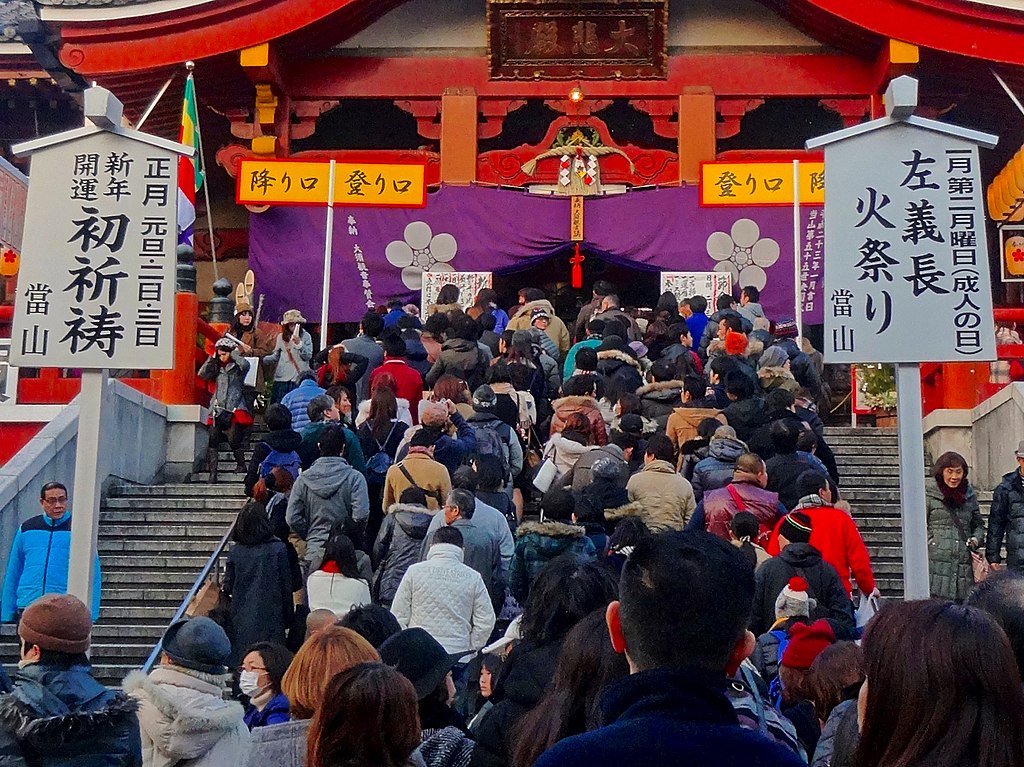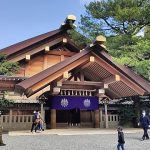Oshogatsu, known as New Year’s, is the biggest holiday in Japan. Businesses shut down from January 1 to January 3, and families come together to spend quality time. During these first three days, the New Year Lottery numbers are announced, New Year cards are exchanged, and most places around Japan appear deserted. Most people all over the country will visit the shrine to pray for prosperity, purchase good luck charms, and write their hopes and dreams on wooden plaques to hang for good fortune in the new year.
Hatsumode is a traditional Japanese custom that takes place during the New Year. People visit Shinto shrines or Buddhist temples to pray for good fortune and a prosperous year ahead. This practice is deeply rooted in Japanese culture and is typically performed between midnight on New Year’s Eve and the third day of the new year (January 1 to January 3).
The term Hatsumode combines “hatsu” (meaning first) and “mode” (meaning shrine visit), signifying the first shrine or temple visit of the Japanese New Year. During this period, many shrines and temples organize special festivities, especially on January 1, to accommodate the visitors participating in Hatsumode.
Besides praying for good luck and a fruitful year, Hatsumode holds great cultural and religious significance. Visitors often engage in various customs and rituals, including ringing bells to bid farewell to the old year. This first visit is an important ritual to start the year on a positive note, seeking blessings and expressing gratitude.
Start the New Year off right by visiting these awe-inspiring shrines.
Atsuta Shrine Hatsumode
Atsuta Jingu is a shrine established almost 1900 years ago, after the sacred sword Kusanagi-no-tsurugi, one of the Imperial symbols, was enshrined there. The shrine has a serene atmosphere, but it can get crowded during the New Year when people flock there to pray. Many ancient and beautiful sacred trees surround the shrine. Traveling there by train instead of by car is recommended, as parking is limited. You can reach the shrine via Jingu Nishi Station on the Meijo (purple) subway line or Jingu-Mae on the Meitetsu line.
Atsuta Shrine
Atsutajingu-Kyu-Cho (Shrine Office) 1-1-1 Jingu, Atsuta-Ku, Nagoya, Japan 456-8585 – Google Map
052-671-4151
www.atsutajingu.or.jp
Osu Kannon Hatsumode
The Osu Kannon Temple was relocated to its current location by the late and great Tokugawa Ieyasu in 1612. The main temple on the site was reconstructed in 1970. The temple’s library houses over 15,000 Buddhist texts, including the oldest known handwritten copy of the “Kojiki,” a historical chronicle of early Japanese history. This temple is one of the easiest to visit on our list, but that doesn’t make it any less worth the trip. Expect to wait in line for at least an hour to ring the bell, and plenty of food stalls are available. Although it may not be as popular as the Ise or Atsuta Shrines, it is still a popular destination.
Osu Kannon
2 Chome-21-47 Osu Naka Ward, Nagoya, Aichi Prefecture 460-0011 – Google Map
052 231 6525
www.osu-kannon.jp
Ise Shrine Hatsumode
Ise Shrine, also known as “Jingu,” is one of Japan’s most significant shrines and cultural treasures, dating back about 2000 years. It was built to honor the goddess Amaterasu-O Mikami, whose tears are believed to have formed Japan’s many islands. The inner sanctum (Naiku) is said to house the sacred mirror, one of the three sacred artifacts, with the other two being the sword at Atsuta. For those living in Nagoya, the mirror at Ise and the sword at Atsuta are close to home. Although you cannot see the sacred artifacts themselves, you can experience the shrine’s spirituality in the holy forest, which was traditionally used to harvest cypress trees for the shrine during ceremonies.
Ise Shrine
1 Ujitachi-Cho, Ise, Mie 516-0023, Japan – Google Map
Tel: 0596-24-1111
www.isejingu.or.jp/en
Inaba Shrine Hatsumode
This shrine worships Inishik Irihiko no Mikoto, the eldest son of the 11th Emperor Sujin. He accomplished various military feats and opened up several regions, creating 800 ponds and ditches, which led to agricultural prosperity and peace. The shrine’s ancient origins involve a mysterious stone called “Kanishi,” which Inishiki Irihiko no Mikoto brought from Oshu to Mino on Emperor Keiko’s command.
〒500-8043 Gifu, Inabadori, 1 Chome−1 (map)
0582625151
www.inabasan.com
Tado Shrine Hatsumode
Three shrines are worth visiting in Japan. The first one is located in the countryside of Kuwana and was established over 1500 years ago. The shrine’s symbol is the horse, and every May, there is a festival where horseback riders wearing samurai armor jump horses over a small cliff. This horse festival is its most famous activity, but it is also a popular destination for New Year’s. However, be prepared to climb stairs, as there are many. It is preferable to travel there by car, although the nearest train station would be Kuwana on the JR or Kintetsu Line. This shrine is located between Nagoya and Ise.
Tado Shrine
1681 Tado Tado-Cho Kuwana-shi Mie-ken 511-0106 – Google Map
0594-48-2037
en.wikipedia.org/wiki/Tado_Shrine
KKPCW, CC BY-SA 4.0, via Wikimedia Commons




